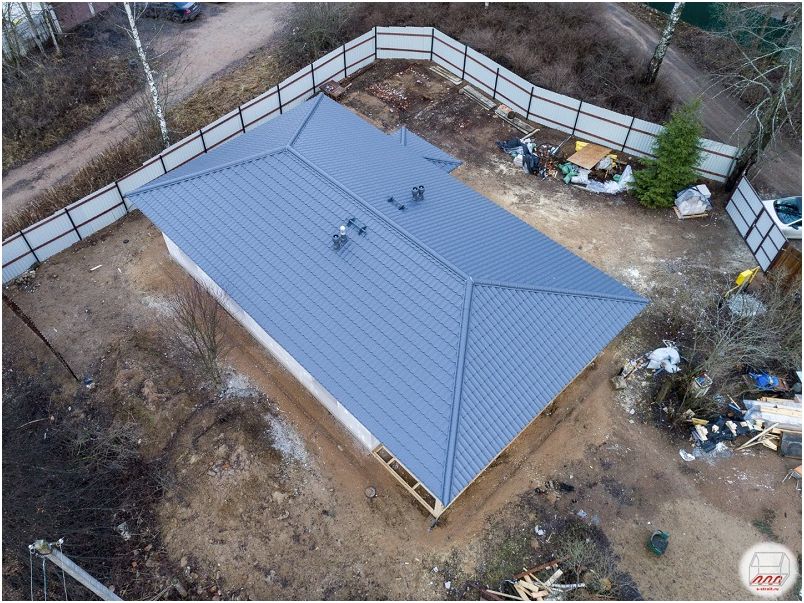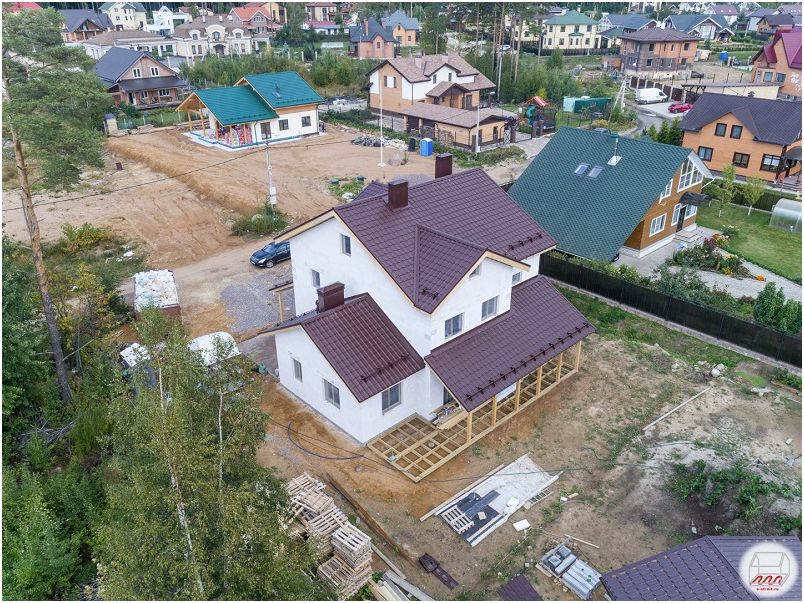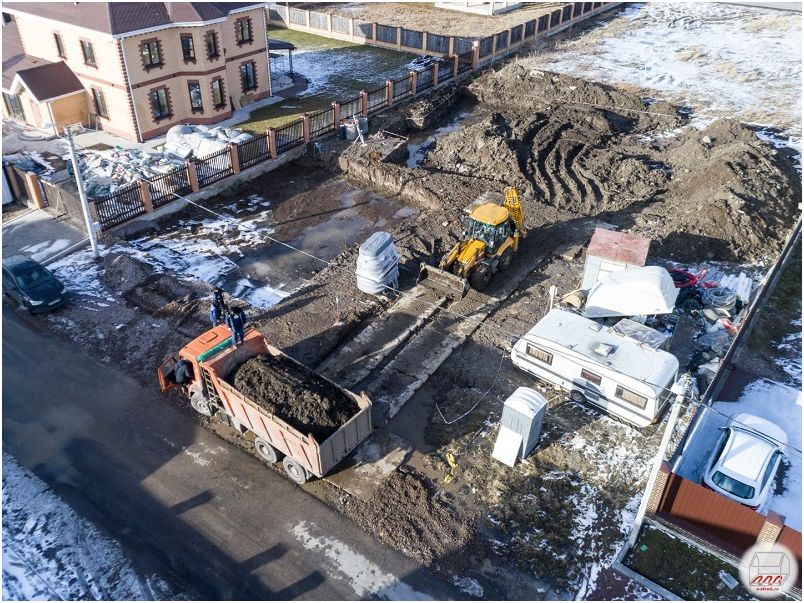Since about the 1920s, the building materials market began to rapidly capture the foamed concrete, or foam block, which was innovative at that time. The technology of its production now seems to be quite simple. The foam generator fills with aluminum powder or powder either cement mortar, or dry mix, or water, which is then mixed with concrete. The result is a chemical reaction that “foams” the cement and fills its interior with honeycomb-like cells. As a result, individual blocks are obtained, which have a closed porous structure and much less weight than an analogue made of pure concrete..
Having decided to build from foam material, it is worth choosing which is better – a house made of aerated concrete or foam concrete. The gas block differs from the foam block in that it, due to a different manufacturing technique, has a smaller volume of porous cells. The strength of such materials is approximately equal, however, aerated concrete retains heat better, is better suited for the construction of solid structures, load-bearing walls of multi-storey buildings, but it is significantly (about one and a half times) more expensive, and besides, it absorbs moisture, which can subsequently lead to the destruction of the material and loss of their heat-insulating properties. The degree of convenience when using both materials is also different: if the foam block can be produced literally at the construction site, adding an appropriate amount of foam to the cement mortar, then the gas block is produced exclusively at the factory – you will have to pay for its delivery to the place of construction of the house.
Pros and cons of a foam block house

Before you start building a house, you need to assess all the positive and negative qualities of the material in an extremely objective and impartial manner. The main reasons why people decide to build a country house from foam concrete are:
- Wide range of applications. Due to the relatively low price and thermal insulation qualities, foam concrete is suitable for laying the foundation of a house, building load-bearing walls, partitions, and other structural elements. It is also used to insulate walls, floors, ceilings..
- High level of sound insulation. To a greater extent, this is relevant for multi-apartment construction within the city, but in private houses the porous structure of the material, which does not allow sound to pass through, is of very good quality..
- Waterproofing. Unlike the gas block, which, when immersed in water, immediately goes to the bottom, foamed concrete, the pores of which are located inside its surface, can be on the surface of the water for a whole week.
- High thermal insulation properties. According to this indicator, houses made of foam concrete are significantly superior to even good red bricks..
- Resistant to temperature extremes. The porous structure allows the walls of a foam block house to maintain a comfortable indoor temperature both in hot and cold weather.
- High fire resistance. Foam concrete is practically not subject to combustion at all, which compares favorably with wooden materials.
- Foamed concrete is easy to cut. This can even be done by hand using a conventional hacksaw. Very convenient for solving non-standard architectural tasks.
- It is not necessary to additionally process the surface. Foam blocks are materials that are very smooth in texture, so you don’t have to level or putty the walls before decorating..
- Very high speed of work. Foam blocks are quickly manufactured, lightweight and easily delivered to the construction site.
Of course, the disadvantages of foam concrete houses are not so obvious, but still they should be taken into account. It:
- Relatively low (when compared with brick) strength of foam block structures.
- The risk of shrinkage, appearing since the time of cracks on the walls of the house.
- Unfavorable ratio of thermal insulation and strength. If you compact the foam block, reducing the pore volume and increasing the proportion of the concrete itself, the house will be strong but cold. Otherwise, with a lower density of foam blocks, the house will maintain a high temperature, but the structure will be quite fragile.
Types of foam concrete

Depending on how exactly you are going to use the foamed concrete blocks, as well as the result you want to achieve, it is worth choosing different materials. For the purpose of use, foam blocks are:
- Constructive. They are used for laying foundations, basements, basements, and the construction of load-bearing walls. This is the densest, respectively – the heaviest type. This includes foamed concrete of grades D1000, D1100, D However, the high density and strength of such a material is achieved at the expense of thermal insulation – such houses will definitely have to be additionally insulated.
- Heat insulating. If you want to insulate your house with petonboton, it is better to use blocks of grades D300, D350, D400, D This is the least dense and lightest of the foamed concrete types. Thanks to the voluminous pores, the thermal conductivity of the walls is minimized, which allows you to maintain an optimal temperature in the premises. However, we must not forget that using such blocks for the construction of too large structures is not only ineffective, but also dangerous..
- Structural and thermal insulation. This is a compromise option that includes medium grades. D500, D600, D700, D800, D900 are suitable for building partitions between rooms, load-bearing walls. They are the golden mean between strength and thermal insulation properties..
How foam block houses are built

Depending on how exactly you are going to use the foamed concrete blocks, as well as the result you want to achieve, it is worth choosing different materials. For the purpose of use, foam blocks are:
- Constructive. They are used for laying foundations, basements, basements, and the construction of load-bearing walls. This is the densest, respectively – the heaviest type. This includes foamed concrete of grades D1000, D1100, D However, the high density and strength of such a material is achieved at the expense of thermal insulation – such houses will definitely have to be additionally insulated.
- Heat insulating. If you want to insulate your house with petonboton, it is better to use blocks of grades D300, D350, D400, D This is the least dense and lightest of the foamed concrete types. Thanks to the voluminous pores, the thermal conductivity of the walls is minimized, which allows you to maintain an optimal temperature in the premises. However, we must not forget that using such blocks for the construction of too large structures is not only ineffective, but also dangerous..
- Structural and thermal insulation. This is a compromise option that includes medium grades. D500, D600, D700, D800, D900 are suitable for building partitions between rooms, load-bearing walls. They are the golden mean between strength and thermal insulation properties..
How foam block houses are built
As a rule, this material is used for the construction of small houses – one-storey, two-storey buildings outside the city, or multi-storey ones – provided the material is reinforced. In any case, a house made entirely of foam is being erected in several stages:
- Design. Calculation of the load on load-bearing walls and other structural elements is very important here. This is due to the relatively low strength of the foam materials. If we are talking about large buildings, it is imperative to take into account the reinforcing belt, which compensates for the fragility of the foam blocks and allows you to build a durable and stable structure. Armopoyas is also used in construction near a reservoir, on subsiding soils or inclined surfaces – in general, where there is an increased effect of water, or you need to level the unevenness of the relief.
- Geological and geodetic surveys of the land. This is necessary to select the type of foundation, assess the prospects for flooding and soil erosion, and take into account the characteristics of the terrain..
- Laying the foundation. At this stage, reinforcement becomes a very important point. This is necessary to strengthen the structure and ensure a reliable structure for the entire future building..
- Walling. This is the stage at which the features of the material are most pronounced. It is worth very carefully approaching the ratio of the strength of foam blocks and wall thickness, taking into account the possible shrinkage of the building. After preparing the base for future walls, all the rows are laid, reinforcement is made. It is very important here not to make mistakes: if you lay one of the side by side not evenly enough, you will have to level the foundation, otherwise cracks on the walls and even partial collapse of the entire building may appear..
- Warming. After the construction of the walls and their complete drying of the walls from the aerated concrete block, you can proceed to the insulation of the walls. There are two possible options – to do it from the inside of the house, or outside. The first option is chosen less often, since in this case the living space is sacrificed, there is a need for additional air ventilation, and increased humidity may appear in the room. Insulating the walls of the house from the outside has more advantages. For houses made of foamed concrete, mineral wool, expanded polystyrene, various types of foamed insulation are usually used for this purpose. It is possible to combine different materials – for example, a combination of foam and mineral wool. Foam concrete crumb can be used for floor insulation.
How much will the construction cost?
If you buy a turnkey house from a foam block, the final price will be formed by such factors as:
- House area.
- The type of foundation, and if necessary, the presence and size of the reinforced belt.
- Basement or basement.
- Quality and thickness of foam block materials.
- Availability and quality of interior decoration.

